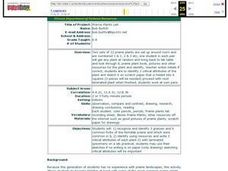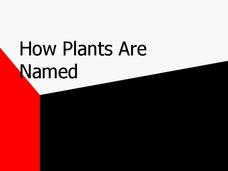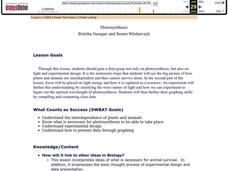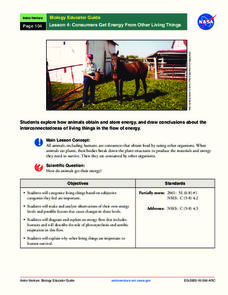Curated OER
How Do Plants Meet Their Needs?
In this plants worksheet, students will compare and contrast the purpose of the flower, fruit, and seeds of a plant. Students will fill in the blank of 5 statements in this graphic organizer.
Curated OER
Parts of Plants
In this plants worksheet, students will complete a graphic organizer by filling in the different parts of a plant including the stems, roots, and leaves.
Curated OER
Flowering Plants
In this flowering plants instructional activity, learners compare the structure and function of a tree trunk and a leaf. This instructional activity has 1 true or false and 5 fill in the blank questions.
Curated OER
Oddball Out- Finding the Item that Does Not Belong- Plants
In this visual comparison worksheet, students examine the pictures of plants in each of 4 rows. They decide which one does not belong. They check their work with the answers which are given at the bottom of the page.
Curated OER
Prairie Plants Lab
Students recognize and identify 3 grasses and 9 common forbs of the fermilab prairie and which were common in IL, identify using resources and write 3 critical attributes of each plant.
Curated OER
Nutrients for Plants and People: Reading Food Labels for Nutrition
Apply work with the food pyramid with this worksheet. Have your class go through their cupboards at home and find 5 different foods to inspect. On this handout, they record the food, what part of the food pyramid this food fits into, and...
Curated OER
Nuclear Energy
Atomic theory as a philosophical study was explored even by the Ancient Greeks. The knowledge of atoms was developed in the 17th century. This PowerPoint explains how by the 1940's, splitting of the atom was discovered and since...
Curated OER
How Plants Are Named
Here is an interesting set of slides that give some nice examples of the reasoning behind scientific Binomial Nomenclature. Some examples of scientific naming are given along with their common names. There is not much more detail on...
Curated OER
How Plants are Named
Genus and species are the 2 categories from which the plant classifications are derived and combined to create a scientific name. The rules for capitalization and underlining are given in these clean and logical slides.
Curated OER
Biomes
Arranged as an interactive lesson, this presentation focuses on the six world biomes. Upcoming biologists click on a specific biome and a slide lists its location, description, native plants, and animals. A quiz provides learners with...
Curated OER
Chalkboard Challenge
Here's a terrific Jeopardy-style game that's designed for 3rd and 4th grade students of science. The topics include living things, animals, plants, matter, and "hodge-podge." The questions are all age appropriate, and there is an...
Curated OER
Habitat Basics
First graders get out and explore two different habitats to examine how each one meets the needs of the plants and animals that dwell there. They discuss what they've learned about animal habitats as they explore the outdoor environment....
Curated OER
Photosynthesis
Students recognize the importance of plants as they perform an experiment involving photosynthesis. Students determine the optimum wavelength of light for photosynthesis by exposing plants to different colors of light, collecting data,...
Curated OER
Photosynthesis Lesson Plans
You can teach students about the importance of plants and the process of photosynthesis with motivating lesson plans. Follow along and find out how one science teacher uses experiments, stories, and her love of plants to get kids excited...
Curated OER
Crowley's Ridge: An Upland in the Lowlands
Young geographers examine how Crowley's Ridge was formed. This is one Arkansa's six natural geologic divisions. The history of Crowley's Ridge is important in that the first settlers of the state were attracted to this region, and it...
Desert Discoveries
The Sonoran Desert
Elementary schoolers study the geographic location of the Sonoran Desert. They pay close attention to the characteristics of the plants and animals found in this desert environment. The student handouts embedded in this plan are...
Curated OER
Observing the Changes: The Warming of the North
After reviewing the causes and effects of climate change, learners become observers for "Plant Watch," a program to monitor the effects of climate change on plants. Students record blooming and leafing dates for selected local species...
California Academy of Science
How Big is Big?
In a math or life science class, "mini-me" models are created with cardstock to reflect a 1:10 scale of learners' bodies. Learners measure each others' heights with meter sticks, and then reduce the size by 10. After this exercise, they...
Curated OER
Room to Grow
Students examine radish plants and compare how they grew based on how closely the seeds were sown. In this life science activity, students pretend to be growing plants crowded together, then examine how the radishes look based on how...
Curated OER
Cycles and Starting Mealworms
Here is a fascinating lesson about the life cycles of plants and animals, and other cycles found in nature. Learners explore the cycle of the moon, the tides, and other sequences of events in every day life. The big activity is the...
MDE k-12
Lesson 5: The Journey Becomes Larger Than Life!
Many muralists throughout history have focused on using their art to represent aspects of their culture or community. After thoroughly researching several muralists, budding artists will create a larger than life mural that contains...
Curated OER
Creating a Three sisters Garden
Students understand that a three sisters garden is comprised of corn, beans and squash. For this three sisters garden lesson, students understand that Native Americans planted three sisters gardens and grow a three sisters garden....
Virginia Department of Education
Photosynthesis and Cellular Respiration
Provide high schoolers with their own indoor gardens! Emerging scientists discuss the process of photosynthesis and germinate seeds before growing plants in multiple lighting conditions. The hands-on application allows...
NASA
Consumers Get Energy From Other Living Things
How do plants and animals get their food? Learn about where energy comes from, how animals store energy, and aerobic respiration, in a instructional activity that allows scholars to diagram energy flows.
Other popular searches
- Life Cycle of a Plant
- Plant Animal Life Cycles
- Life Cycle of Plant
- "Life Cycle" Plant
- Plant, Animal Life Cycles
- Life Cycle Plant
- Life Cycle Bean Plant
- Life Cycle Flowering Plant
- Life Cycle of a Bean Plant
- Science Life Cycle of a Plant
- Life Cycles of a Plant
- Plant Lifecycles

























